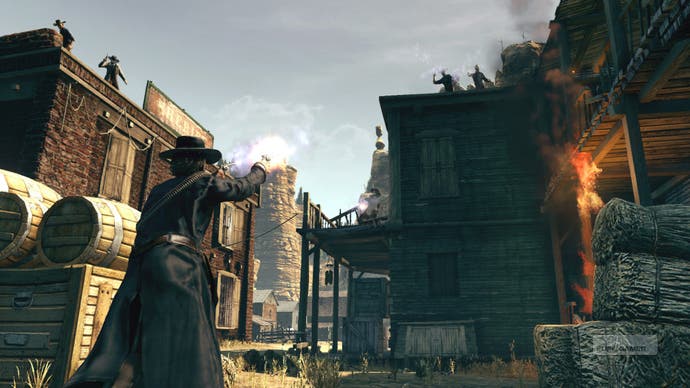Call of Juarez: Bound in Blood
Call to order.
You could argue that the Wild West is a tough sell for a videogame. It may have been the reliable staple of action-packed kids' entertainment for years, but those who grew up daydreaming of cowboys were doing so long before the joypad made an appearance. Kids today - and by kids, I refer to most people under the age of 40 - seemingly all grew up wanting to be tormented superheroes, homoerotic space marines or superstars of reality TV. Where's the room for a Western adventure in that?
Yet there's still enough love out there for the brutal tales of the Old West to ensure that developers return to its themes every couple of years. When you play a game like the original Call of Juarez, you understand why. Atmospheric, good-looking and innovative, it combined stealth and all-out action very neatly. Most importantly, it introduced us to Reverend Ray, the gloriously unhinged outlaw-turned-preacher who intoned fire and brimstone Bible verses in a voice that sounded like it was being produced by a bulldozer's engine while gun-slinging his way through wave after wave of hapless sinners.
You don't create a character like that and then just walk away. So, having shown us Ray as a Reverend, developer Techland is doing the logical thing next - a prequel, where we get to see Ray the Outlaw, playing through the events that turn him into God's instrument of slightly demented vengeance. What that means is that this is another opportunity to storm through the Old West, rendered even more lawless than usual by the devastation of the Civil War, with Ray's gravelly tones narrating you through the carnage. In this, the core appeal of the game appears to be broadly unchanged - and so, too, is the central conceit of its gunplay.
Westerns, after all, are all about the almost mythological status of the gunslinger, and Ray is no exception. Kill enough enemies through normal means, and you'll receive the ability to enter 'concentration mode', which stops time, allowing you to drag the crosshair over your enemies for a few seconds, and promptly shoot them all when the timer runs out. A second version of the ability, wielded by the game's other playable character, Thomas, is more like a rapid-fire heat-seeking attack. In both cases, once the ability has been charged up, you've got to use it within a set time or you lose it, preventing you from stockpiling it, and keeping the game's action flowing nicely.

Thomas, by the way, is Ray's brother - explaining the game's subtitle - and with a more tactical, long-distance fighting style, he provides a gameplay foil to Ray's death-dealing juggernaut. The plot set-up has them both serving in the American Civil War, but soon deserting for personal reasons and heading further west, fighting all manner of foes including their former army comrades. In the early levels I've played, Techland has made the most of the Civil War setting, with large-scale environments crisscrossed by trenches and defined by mud and rolling palls of smoke.
The game looks pretty fantastic in general, and it's equally at home in confined environments - such as some of the claustrophobic trenches - and in wide open vistas. The scenery was one of the high points of the original game, and it'll be interesting to see what new wonders Techland can pull off with its latest engine technology. The action winds its way down through Mexico and there's talk of Incan ziggurats and all sorts by the end - making it hard to imagine the developers resisting the urge to show off with some breathtaking vistas.








